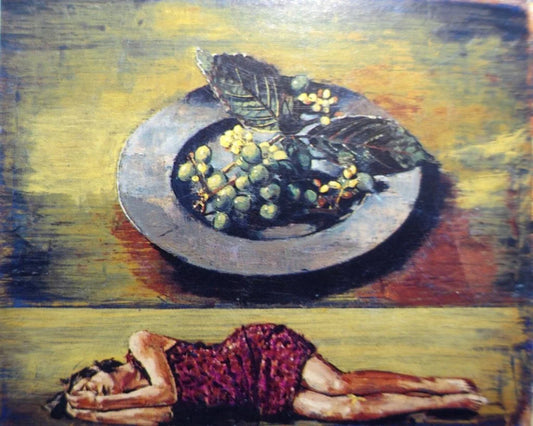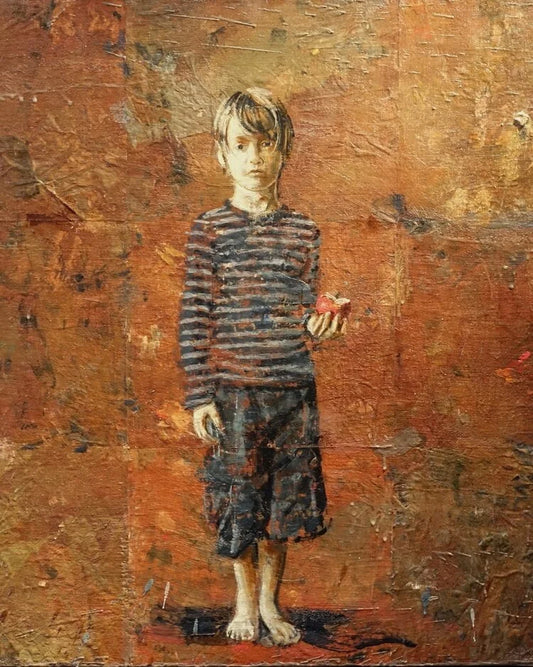Collection: Payette, Jacques
-
Jacques Payette - Couché Près Des Fruits / Encaustic/Canvas, 24×30 in // 60.96×76.20 cm
Vendor:Galerie NuancesRegular price $0.00Regular price -
Jacques Payette - L’herbe Folle Qui Pousse Dans Mes Mains/ Encaustic/Canvas, 2009-2010, 32.5×38.5 in // 82.55×97.79 cm
Vendor:Galerie NuancesRegular price $0.00Regular price
Request for information
Jacques Payette, a great artist of encaustic paintings
A great Canadian master, self-taught, Jacques Payette was born in Montreal in 1951. His work mainly includes encaustic paintings (hot wax in which the color pigments are suspended, imprisoned, sealed from the moment the wax cools), a difficult and very ancient technique that he masters with remarkable skill.
A contemporary painter
"Jacques Payette drew a lot of inspiration from his family life and his love for his partner. The feelings, although discreet, are nevertheless present and expressed through situations suggesting a metaphysical intensity, particularly in his series from the 1980s. For art lovers who have followed his work for thirty years, they have felt, like me, this impression of intimacy, of proximity to his world, and sensed this calm and warm breath of shared feelings." Robert Bernier.
"I have a fascination with absence, loss, and the passage of time. But it is only the present that passes, for the past remains." "It takes a lot of stubbornness, and no doubt strength of character, to persist in a genre that is not fashionable. But it is even more perilous to follow fashions, since they go out of fashion. Above all, you have to remain honest with yourself." "I chose to paint (or is it painting that chose me) to try to understand, feel, and appreciate the people and the world in which I wander. I like to watch the light pass during the day, this light that will die in its night, and I am not sure I was dreaming" Jacques Payette.
Jacques Payette has participated in numerous solo and group exhibitions in Quebec, Calgary, Toronto, Vancouver, New York, Mexico City, and Paris. His works of art can be found in several major museum collections, both private and public, such as the Musée national des beaux-arts du Québec, the Musée d'art de Joliette, the Musée des beaux-arts de Sherbrooke, the Musée d'art contemporain de Montréal, and the Canada Council Art Bank.
ADDITIONAL ARTICLE(S):
Jacques Payette (1951)
Jacques Payette was born in Montreal on June 6, 1951. Self-taught, he learned his art through reading, numerous essays, and reflections. He kept away from educational institutions, which allowed him to maintain his creative freedom and remain attentive to his own needs. His development was rapid. He first painted a series where the themes of light, architectural structure, and visual distortion predominated. Then Payette left more space for the material. This dimension of his work is very important: he needs to manipulate, to have direct contact with the material. Like an intimate ritual where the conscious and the unconscious merge, this approach allows him to achieve a preparatory and complementary concentration for his subject. The gesture nourishes the concept, develops it, and brings it to life in the concrete.
In the series Baisers d'Italie, created in the mid-eighties, Payette uses Prismacolor pencils on a canvas dyed in a dark color, a blackened umber. His large amorous landscapes depict the artist and his companion in multiple embraces. He approaches this theme as it should be, through a representation and design imbued with personal symbolism. Also, Jacques Payette has a great admiration for the Italian Renaissance artist Piero della Francesca and draws inspiration from him in the design of the landscapes that accompany his figures. The two embracing partners dominate the pictorial space like giants. A double allusion, first to the Italian artist who used to paint his landscapes in the distance, and second, to the feeling of love that drives the couple. In some paintings, Jacques Payette paints houses with unusual architecture placed at the feet of the figures in tiny scale. This is a way of emphasizing the lure of the landscape, which, this time, is no longer in the distance but in miniature. In Kisses from Italy, all the elements advocated by the artist aim to make the viewer complicit in both this affectionate nod to this great artist he admires and his tender gaze on the accomplice of his life. It allows him to create associative relationships of a different order that link the elements together and reveal the invisible, the mystery that inhabits the character.
Jacques Payette's painting also has an unusual characteristic: that of using different techniques. Each sequence illustrates an artistic approach that seems to adapt to the subject being treated and what it inspires in the artist. Thus, for a series where the temporal dimension is important, Jacques Payette uses acrylic mixed with baking soda, as well as paint stripper and residue obtained from sweeping the studio. Everything is heated using equally original means devised by the artist. In his more recent works, Jacques Payette uses encaustic, an ancient technique that he adapts to the reality of today's materials, while retaining its original base, wax. Payette's encaustic consists of a mixture of wax, microcrystalline, and resin that stabilizes the chromatic value of the pigments. Everything is heated using a barbecue lighter. Of course, it is not necessary to know all of this information to understand the artist's work or to read it, but it is essential to grasp the importance of the process that accompanies the creative act, since it is an integral part of the work.
Source: Robert Bernier, A Century of Painting in Quebec Nature and Landscape, Les Éditions de l'Homme, 1999, Jacques Payette, pages 298-299.
TO LEARN MORE:
. NATIONAL MUSEUM OF FINE ARTS OF QUEBEC - JACQUES PAYETTE
. JOURNAL DE QUÉBEC - L’INCROYABLE TRÉSOR SECRET DU PEINTRE JACQUES PAYETTE
. JACQUES PAYETTE


